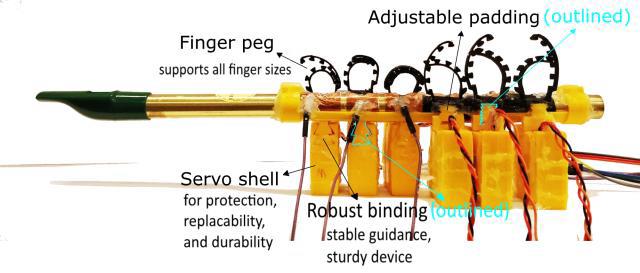Yian Zhang Yinmiao Li Daniel Chin Gus G. Xia
Music X Lab
New York University, Shanghai
ABSTRACT
Haptic interfaces have untapped the sense of touch to assist multimodal music learning. We have recently seen various improvements of interface design on tactile feedback and force guidance aiming to make instrument learning more effective. However, most interfaces are still quite static; they cannot yet sense the learning progress and adjust the tutoring strategy accordingly. To solve this problem, we contribute an adaptive haptic interface based on the latest design of haptic flute. We first adopted a clutch mechanism to enable the interface to turn on and off the haptic control flexibly in real time. The interactive tutor is then able to follow human performances and apply the “teacher force” only when the software instructs so. Finally, we incorporated the adaptive interface with a step-by-step dynamic learning strategy. Experimental results showed that dynamic learning dramatically outperforms static learning, which boosts the learning rate by and shrinks the forgetting chance by 86%.
I chose this paper, because I am music teacher. Further was my bachelor thesis about the learning of the Diatonic Accordion in Digital Age. I noticed that learning an instrument independently is really an advantage, also to be flexible in time, but there was no checking, if the musician is playing correctly. I do not mean the right score, but rather the right attitude while playing the instrument and the correct technique. I criticized in my thesis that learning an instrument only via Video without any checking tool, for example an interactive-haptic instrument, is not the best way of learning an instrument. Traditional Learning would be in this case always better, because of getting feedback and hints for a better performance.
Now with the invention of this interactive-haptic instrument we come closer to our image of distance learning with good quality. For sure, this is not the end of the invention. In best case it will develop to a smarter and multifunctional concept, useable for more instruments. Critique: This haptic flute is an extra built instrument with all its features, but there are also people, who buy a flute, and did not think about the learning method before. Or people, who change from Traditional Learning to Haptic Guided or Adaptive Learning. In most situations they will not buy another instrument, so the solution would be a wearable interface or an interactive-haptic interface to readjust on the traditional instrument, for example on the flute. I think to buy generally interactive-haptic instruments is for our society just now not the first choice. Maybe because the image of a specific instrument gets destroyed or the image changes to a new instrument. It is often a reason to learn an instrument because someone likes the form or the characteristic looking of it. Underneath the interactive-haptic flute can be compared with a traditional flute. It is very clear, there are two different instruments. The common flute looks much more beautiful and attractive. I think that for musicians the looking of an instrument is very important and a part of their personality, it would be very difficult to change this specific image of an instrument, which exists since 1000 or several hundreds of years.


Beside above aspects the interactive-haptic instrument is still an invention in a positive trend concerning Haptic Guided Learning. This new system of Adaptive Learning allows more freedom as a Fully Haptic Guided Learning. The effectiveness of dynamic learning boosts the learning rate by 45.3% and shrinks the forgetting chance by 86%.
In summary this interactive-haptic instrument is a good invention for distance learning or people, who do not have the opportunity to learn in a traditional way. Furthermore it is another step in developing smarter and multifunctional concepts of haptic interfaces.
To get used to the looking of this new invention it will need some time and rethinking, people have to differ between a learning tool instrument and a traditional instrument, they have to accept that this is not the same and it must not be the same, as long as there exists no wearable or an interface to readjust.